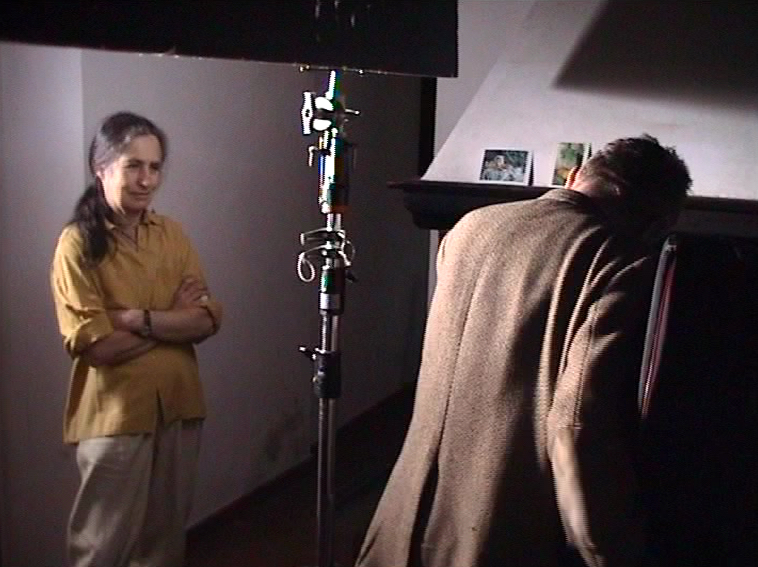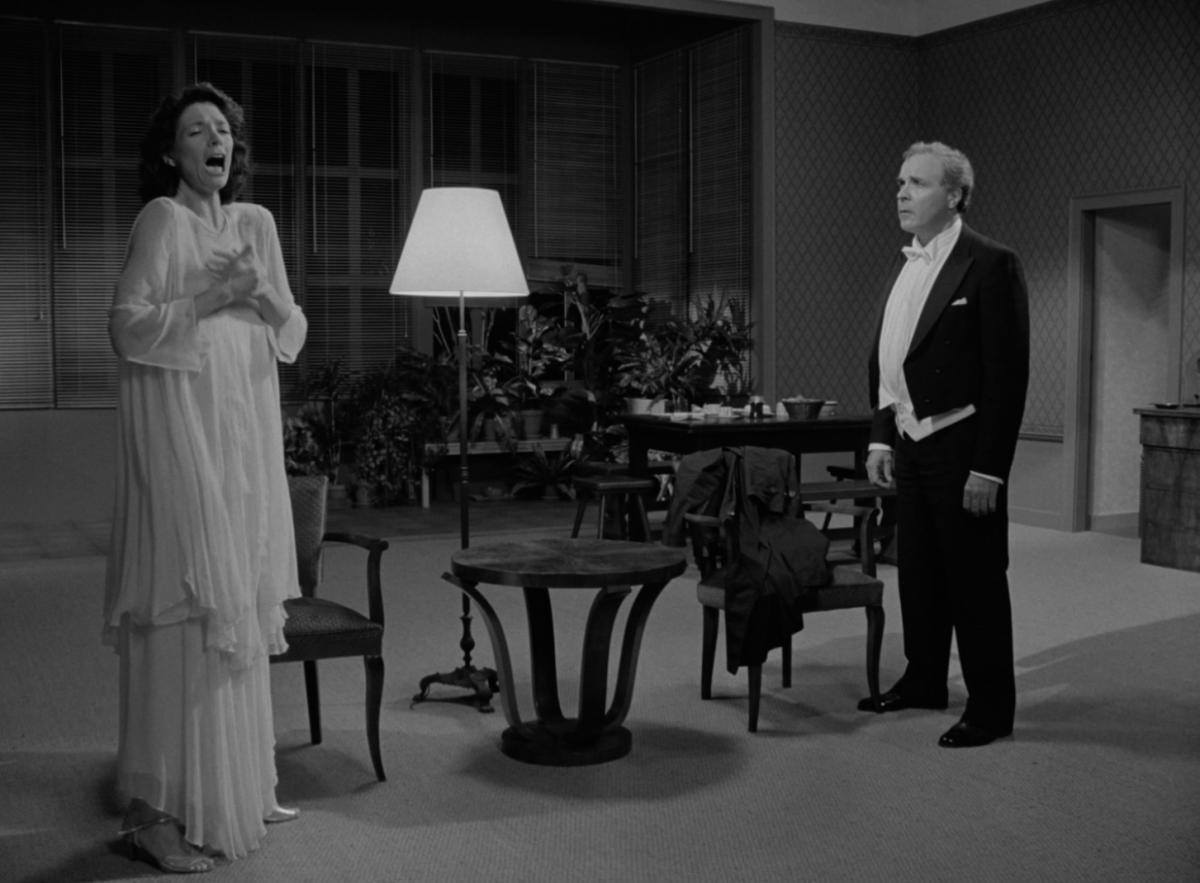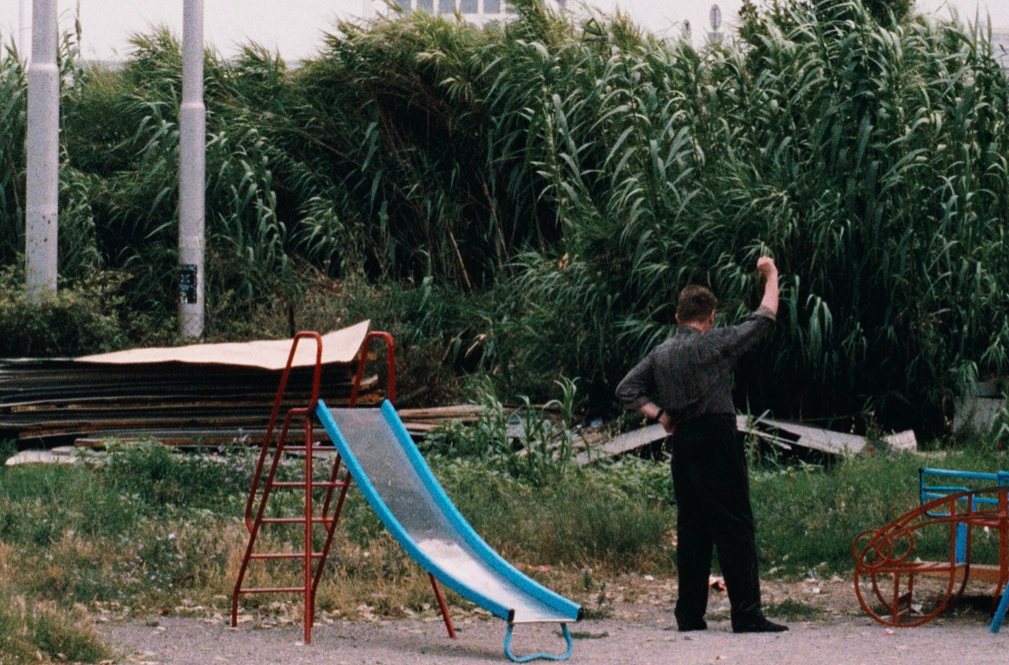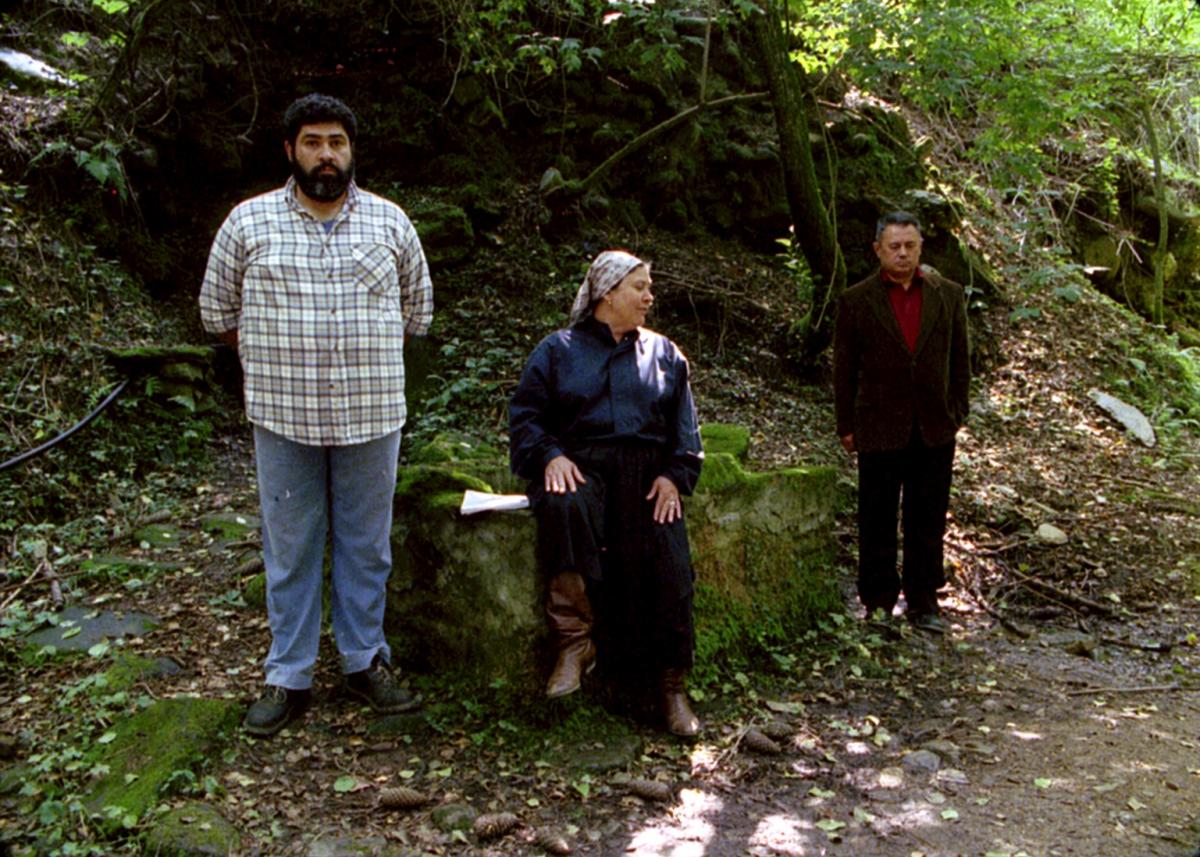At Work with Danièle Huillet and Jean-Marie Straub
A Conversation with Jean-Charles Fitoussi

Oscar Pedersen: How did you meet Danièle Huillet and Jean-Marie Straub?
Jean-Charles Fitoussi: After I had finished my first film, Aura été (1994), a friend told me I should watch the Straubs’ films. I did, and I was impressed. When I was in Rome shooting my second film, D’ici là (1997), I simply found their number in the phone book and phoned them. I explained that I was shooting a film and I would like to meet them. Straub accepted but warned me, “You will never find our house.” And it was true, it was very complicated to find; somewhere in the suburbs of Rome, near the airport. The roads were all dead ends, so you had to drive around and try again, but finally, I found them. I buzzed the door phone, and he answered, “I’m coming, but you must know I absolutely refuse to be filmed”. Then we talked about… I don’t know… about John Ford and Fritz Lang, and I explained my film. Suddenly he said: “When are we shooting?” and so, he entered my film. He played a very small part, but after that, I suggested to Danièle and Jean-Marie that I could assist them with their films.
One year later, when they were about to make Von heute auf morgen (1997), they contacted me. I suppose it went okay because they asked me to work with them again for the next ten years.
Huillet and Straub worked with small crews. How did their working method differ from what you had experienced prior to this?
I had been an assistant on one film before working with the Straubs, and it was of course completely different. Danièle was the real first assistant, not me. She was the organizer of everything. Everything had been planned. They rehearsed extensively with the actors, so they knew all the parts before shooting. They had also done the découpage. In fact, a script by Huillet and Straub was the découpage, it did not consist of just dialogue, everything had been worked out and divided into a series of shots. They knew what was needed for each shot, what lens to use, from which point of view to film, etc. In short, everything was so well prepared that you had plenty of time on set.
This remains the main difference between how they worked and the standardised way. On other sets, everybody is rushing, fighting against time, being completely hysterical. With Huillet and Straub, it is the opposite. As they often said, having time was their luxury. We had time to wait, to wait for the miracles, for the light to be unpredictable, and so on. It was very peaceful.
What was your role as an assistant?
It was a very small part. We were two assistants. Since Danièle had planned everything so well, our role was to transport the negatives back to France, to the French laboratory, traveling by night train. They were very heavy, the rushes, and you had to protect them like a child because Huillet and Straub did not trust the mail couriers. So, you took care of it, and when you arrived in the morning, you would go to the laboratory to develop the film. You would spend one night in Paris, and the next morning you would return to the laboratory to review the positive print. You always had to check them, to see how the blacks and whites had turned out, to see if the contrast was what the Straubs wanted. So, I was kind of a spy. I would go to the screening, and I’d call Danièle to describe what had been developed. Sometimes I noticed something in the images that the laboratory had not mentioned, so she called the laboratory with notes and told them to produce a new print. Naturally, the laboratory did not like me. Once, they intentionally told me the wrong screening time, so when I arrived the print had already been screened, and they assured me, “No, no, it’s already over, there are no problems, we do not need to waste your time.” Danièle called, “Don’t you ever do that again! We must see.” I was kind of an extended eye. The following night I would return to Italy with the positives and Huillet and Straub would screen the material.
Is that also what is shown in Sicilia! Si gira (2001) – which follows the production of Sicilia! (1999) – when Straub points to a screen, commenting on the light?
Yes, exactly, when he says that the black and white reminds him of Journal d’un curé de campagne (Robert Bresson, 1951). So that is how we worked as assistants. As mentioned, we were two assistants and we always switched places; travelled back and forth during the night by train. One was on set while the other was in Paris, and vice versa. On set, there were very few things to do because it was so quiet and thought-out. When we were making Von heute auf morgen in Frankfurt, I noticed this, and when we were about to make Sicilia!, I asked if I could film the production. If I was invisible, it would be okay, they told me.
Did your role ever change during the ten years of working together?
No, it was always the same. Nothing changed. The only change was during Sicilia!, where I also travelled by plane. Danièle and Jean-Marie did not want the negatives to be x-rayed. It was hard to convince security to let me travel without the x-ray scan. The director of photography had said to Danièle and Jean-Marie that the negatives would not be affected by x-ray, but even so, they did not want it. It was funny. Once the airport police had to drive me by car because I could not get through security. Today, it would be completely impossible.

You mentioned the luxury of having time. I guess it was this luxury that allowed them to work so meticulously with the framing of each shot.
Yes, that is also what I try show in my film, Sicilia! Si gira. We see that for the interior scenes in Sicilia!, there is only one point of view. It is from this single point of view that all the shots are filmed. There is one and only one camera eye that sees everything. In other words, the space is not modified during the whole sequence. It is only the lenses that change. You, therefore, have a sense of space, which you won’t find in other films. To find this point of perspective is kind of a geometrical problem. You have the space, and the actors’ positions, and then you try out different camera positions. It is patient work. You move the camera, little by little. Once you have found the position of the camera, it will not move. Not for weeks. Until every shot has been carried out, the camera will not move, only pan around.
In other productions, you normally record the whole scene from one camera position and then you move on to the next. You save time and money. There is an economic logic to this. But this is not what Danièle and Jean-Marie did. They shot in the order of sequence. If two people were talking in a scene, they shot one piece of dialogue in shot A, then changed perspective to shot B, another piece of dialogue, and then they moved back, trying to find the framing of shot A again. When they filmed inside, they had to change the light, etc., for each shot. I believe that when you see the film, you feel that – that the framing has moved, that the shot does not belong to exactly the same moment as the shot before. You do not only get a feeling of space but also a feeling of time. You sense that time has passed between shots. I remember Straub saying that… Eisenstein, I believe, did the same thing. Even when Eisenstein had the same shot repeating in a sequence, he was re-finding the shot instead of filming the whole scene one shot after another. I am not sure I remember correctly, but I think Straub said that Dreyer did something similar.
And the sound, I presume, was also recorded shot by shot?
With sound, as you know, it was all direct sound. No postproduction, and no sound editing, it was only one mono track. The sound was made shot by shot, yes. A change did occur, however, during the making of Sicilia!, after their regular sound engineer, Louis Hochet, had passed away and Jean-Pierre Duret took over. When Jean-Pierre arrived in Italy, we were in the forest. He wanted to add another microphone, which was very unorthodox. There had only been one microphone for years. But he asked if he could place a microphone near a river. Danièle did not want to forbid it, because she wanted to respect his idea, but she did not guarantee to use it. So, quite far from the actors, he placed a microphone. I am not sure if they ended up using the river. But after this film, they always let him put another microphone where he wanted. I should ask him if he checked during the mixing if they kept it or not.
This also testifies to the convergence of the intentional and coincidental that permeate their way of working. They work to reach the point where the unruliness of the world can enter the image.
Yes, to welcome that which is different and bigger than yourself. When each camera position had been found, you would shoot many takes for the text to be carried out correctly. But you also allow chances to happen. An actor can move or say something in a nice way that hadn’t been tried in other takes, and suddenly you hear, I don’t know, a bird or a horse, or the light can be special. The aim is to be open for chances to happen. That is why you have a feeling of reality and the presence of the world in their films.
You mentioned that you were working on D’ici là when you met Huillet and Straub. Did their approach to cinema change your own way of directing?
They give you the strength to work against the technical standards a bit and make a simpler cinema. And you do not need many people to make a film. You can do precise things with a small crew, with people you trust, and with time. After meeting the Straubs, my own sets were much more peaceful because we had time. That was the main thing. When you talk to your producer about making a film, you discuss the length of the shoot. And since you have to do many, many things in a short period of time, you end up rushing, and you can no longer see what you are doing. If you normally need eight weeks for a shoot, but you can only get six, it is crazy not to cut down the material to fit six weeks. If you try to make eight weeks’ worth of material in six, you will make horrible stuff, so you must adapt what you have to shoot to the time you can shoot it in.

In D’ici là, there is a shot of Straub standing in front of some thick bushes and piles of metal. Next to him is a worn-down slide, he raises his right hand in an act of resistance. It is a dense image: Straub, the slide, the fist. The next image is of a child talking about the grandness of the world.In your view, how does childhood connect with Huillet and Straub’s cinema?
From the time you are born, your eyes are open, and you see everything for the first time. The older you get, the less you are surprised by things. But things have not changed, it is just you who have changed, things can still be very surprising. It is such a pity that we are losing the perception of how surprising things are. I believe that in Huillet and Straub’s films, you are given back the feeling of a surprising world. To see the things that are in front of you becomes completely incredible. It is almost a religious experience. You are so present at that moment that everything becomes of great importance. In Godard’s Hélas pour moi (1993), a person talks about wanting to see the lizard in one of the Straubs’ films. This is exactly the point, all of a sudden you see it, or you see a fly, really see it. The fly has the same importance as the war or anything else. I think this is the privilege of a child (or a drunken man): to look at things and be astonished. Also, the découpage, the framing, all of Danièle and Jean-Marie’s films are very simple. Of course, you have to be skilful to get to this point, but it is the opposite of technical virtuosity. They kept the cinema of the Lumières’.
When people discovered the Lumières’ cinématographe, they were in awe of seeing a tree, of seeing what they saw every day, but now as a discovery. The leaves were moving, it was obvious, but they had not paid attention. Because of the cinématographe, they did. It revealed new joys that were accessible to everyone, simply the joy of seeing, hence the joy of being. This was lost very quickly. There is a famous sentence by Pavese, which I believe Straub used in Dalla nube alla resistenza (1979): “The surest, and the quickest, way for us to arouse the sense of wonder is to stare, unafraid, at a single object. Suddenly – miraculously – it will look like something we have never seen before.” It is like when you pronounce a word many times, isolated from its sentence. This word will become strange, this very common word. It reminds me of Antoine Doinel repeating his name in front of the mirror in Baisers volés (François Truffaut, 1968): Antoine Doinel Antoine Doinel Antoine Doinel… and then the name becomes something else, Fabienne Tabard Fabienne Tabard Fabienne Tabard… So, this is why their films ring with such intense joy, it is simply the joy of being in the world. A joy that is so easy to lose.
It is an uncomplicated cinema in the sense that is fundamental.
Yes, that is right.
You began working with Danièle Huillet and Jean-Marie Straub in 1997 during the production of Von heute auf morgen. The film is tied to their general method and interests, including Arnold Schönberg’s operas, but it also varies somewhat from the films preceding and following it, e.g. Lothringen! (1994) and Sicilia!. For one thing, it was filmed on a sound stage. The sound stage allowed them to record sound in ways that hadn’t been possible during the filming of their other Schönberg opera, Moses und Aron (1975). Did they discuss their interest in this opera with you?
Perhaps it is best to view each film as its own, following its own rules. After Operai, contadini (2001), I think, they began making variations on the same rules and subjects, you know, like Bach did with The Art of Fugue, one motif played in variation. We see this with Operai, contadini and Umiliati (2003), for example… Itinéraire de Jean Bricard (2008) connects to Trop tôt/Trop tard (1981)… But still, each film has its own rules. I am not sure why they suddenly decided to film Von heute auf morgen after Lothringen!.
But there is no doubt that the production of Von heute auf morgen differed from the other Straub films I worked on. First, it was inside. But also technically, the film demanded something different. There was an orchestra of 70 musicians playing, which was recorded using direct sound. So, like the camera, there was a découpage for the score. A découpage to note when you could cut in accordance with each shot. The score was never recorded in one, but in fragments and put together in the editing. When viewing the film, your ears can hear the continuity of the music, but your eyes can discover the structure of the score, its skeleton. Even if you can’t hear it, you know that there has been a cut in both the image and sound. That’s incredible.
Le genou d’Artémide (2008) and Itinéraire de Jean Bricard was the first films after Danièle Huillet’s passing. How did you experience these two productions?
Well, they had prepared Itinéraire de Jean Bricard before Danièle’s passing. So, it was a shared project, different from the films he would make afterward. The shooting was of course different in the sense that Danièle was not there, but the production method did not change. Now there were only two eyes and two ears whereas before there had been four eyes and four ears. When Danièle was alive and they were making films, she would go to sleep very, very late. She was always working on the texts and feeding the dogs and the cats. She was also the producer and she spent much of her time finding partners and funding, so when she died, it was also the end of 35mm.
How come you stopped making films with Straub after Itinéraire de Jean Bricard?
He did not need me anymore since he stopped shooting on film and turned to video. No need to take the night train any longer.
When was the last time you saw Jean-Marie?
It was in May 2018 in Metz, his city of birth, which awarded him the city’s medal of honour, making him an “honorary citizen”. He was in a wheelchair and was much less talkative than usual, at least in public. In fact, I don’t think he said a word. He seemed vaguely indifferent to the ceremony that honoured him, but the presence of young children, themselves strangers to the comical conventions of adults, kept him enthralled.
Paris, March 20, 2023.

Image (1) from Sicilia! Si gira (Jean-Charles Fitoussi, 2001)
Image (2) from Von heute auf morgen (Jean-Marie Straub & Danièle Huillet, 1997)
Image (3) from D’ici là (Jean-Charles Fitoussi, 1997)
Image (4) from Operai, contadini (Jean-Marie Straub & Danièle Huillet, 2001)
With thanks to Oscar Pedersen, Viktor Retoft and Balthazar.
This article was originally published in Balthazar no. 9, 2023, dedicated to the work of Danièle Huillet and Jean-Marie Straub.

